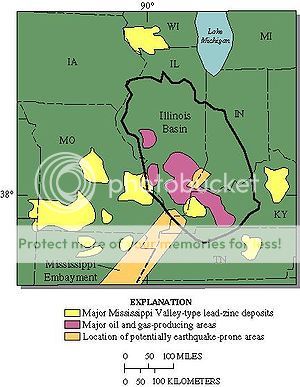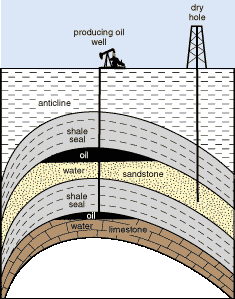This earthcache is located in Harmonie State Park in the middle of the Illinois Basin.
To log this Earthcache, Please email me the answers to the following questions. Failure to do this will result in your log being deleted.
1. At the posted coordinates, what structure do you see?
2. What are the 3 types of rocks that typically make up a reservoir?
3. In your own opinion, How do you think this oil got here?
4. From the sign at posted coordinates, What is a fossil fuel formed from once living material?

Illinois and Indiana have about 650 oil fields, primarily in the southern half of the states. You can recognize an oil field by the presence of "rocking" oil pump jacks and clusters of large storage tanks. Deep beneath this equipment—typically about ½ mile deep—lie one or more layers of porous rock called "reservoirs" that contain the "black gold." Oil flows from the reservoir into the 4- to 8-inch-pipe in the oil well. 1 barrel of oil equals 42 gallons of gasoline.
Drilling for oil has always been a risky financial venture because fewer than half of the holes drilled actually strike enough oil to repay the drilling costs. Unsuccessful wells, called "dry holes," are filled with cement and plugged to protect the groundwater.
Where is oil found?
The oil reservoir is typically composed of layers of sandstone, limestone, or dolomite. The reservoir rock has tiny pores, and, in many cases, cracks or fissures, that are filled with oil, gas, and water. The pores and cracks are connected, so that when a well is drilled into the reservoir, the fluids in the pores can drain into the well.
Above an oil reservoir is a layer of shale or other fine-grained rock through which water or oil cannot pass. This layer acts like a seal or cap over the actual reservoir.
Some Indiana reservoirs are found in dolomite. This rock is similar to limestone but has been chemically altered. The limestone has been recrystalized to form fine-grained dolomite, a process that may dissolve fossils and limestone to form large and small holes (pores) that can hold oil.
Reservoir sandstone has individual sand grains that are slightly cemented together. Several sand grains could fit on the head of a pin, but there are still many pores or spaces between the grains that can hold oil. These sand grains were originally deposited in river channels and deltas or as sandbars and beaches in a shallow sea. Limestone reservoir rock may consist of sand-sized or larger fragments of corals, sponges, snails, clams, and other marine animals. Many ancient limestone reef deposits in Indiana contain oil.
Getting the oil out
Deep in the well is a pump that is connected to the surface by long steel rods. When the pump jack at the surface is rocking up and down, it opens and closes valves in the submerged pump. Each stroke brings a cup or two of fluid up to the surface. This fluid, generally a mixture of oil and water, must be separated by an oil-water separator. The separator takes advantage of the fact that oil floats on water. Once separated, the oil is stored in large tanks before it is transferred by pipeline or truck to the refinery and the water is safely pumped back into the ground.
Where did oil come from?

Most of the oil in Indiana reservoirs came from layers of shale rich in organic matter, the remains of microscopic plants and animals that lived in a shallow ocean that covered Indiana about 360 million years ago. As the plants and animals died, their remains settled into the mud at the bottom of the ocean. Because the sediments and surrounding water contained almost no oxygen, the organic matter was preserved. This mud was buried and compressed beneath successive layers of sediment to form a rock called shale. Because the earth gets warmer with increasing depth, the shale eventually reached a temperature of about 200°F, when the heat began to break down the organic material— “cooking” the organic matter in the sediment and forming oil, which later migrated from the shale into the reservoir rock.
The hydrocarbon kitchen
Oil in the Illinois Basin is produced from a temperature-pressure zone called the "hydrocarbon kitchen." Here the most important organic-rich, oil-generating black shale in Indiana, called the New Albany Shale, was "cooked" enough to convert organic matter into oil. Oil was then expelled from the shale and migrated upward along cracks, fractures, or through porous and permeable-strata to the oil reservoirs. This migration is usually nearly vertical, and thus most of the oil fields occur in the area outlined by the "kitchen" boundary. Notice that oil is also found in reservoirs many tens of miles outside the kitchen. The oil reached these reservoirs through porous and permeable layers that acted like slightly inclined pipes that transported the oil far from the kitchen. Geologists say that the oil "migrated laterally" to these reservoirs. The oil fields in western Illinois and south western Indiana are good examples of fields that required lateral migration.
Because oil is lighter than water, it tends to rise through the layers of the earth. If its way is blocked by a layer of shale or other impervious rock layer, the oil can move sideways through the pores and cracks in the rock layers until it is finally trapped in an upwardly arched bed called an "anticline" or against a fault plane; if the oil can reach the earth's surface, it forms a tar seep. One of the most famous seeps in the world is at the La Brea Tar Pits, which are located in Los Angeles, California.
When they explore for oil, geologists look for anticlines and other traps. Some of the anticlines in Indiana may be a mile or more across and several miles long. More than one layer of rocks in these folded strata might trap oil. Some of the biggest oil fields have over 2,000 oil wells and contain over 200,000,000 barrels of oil; that is more than 8.4 billion gallons of oil